Page 29 of 251
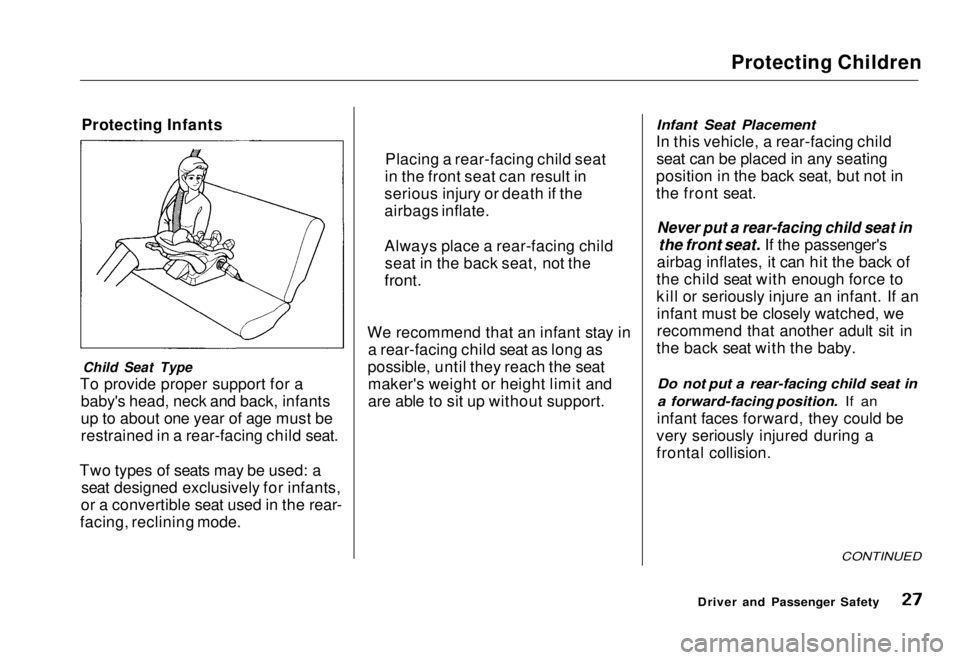
Protecting Children
Protecting Infants
Child Seat Type
To provide proper support for a baby's head, neck and back, infants
up to about one year of age must be
restrained in a rear-facing child seat.
Two types of seats may be used: a seat designed exclusively for infants,
or a convertible seat used in the rear-
facing, reclining mode. We recommend that an infant stay in
a rear-facing child seat as long as
possible, until they reach the seat maker's weight or height limit and
are able to sit up without support.
Infant Seat Placement
In this vehicle, a rear-facing child seat can be placed in any seating
position in the back seat, but not in
the front seat.
Never put a rear-facing child seat in
the front seat. If the passenger's
airbag inflates, it can hit the back of
the child seat with enough force to
kill or seriously injure an infant. If an infant must be closely watched, we
recommend that another adult sit in
the back seat with the baby.
Do not put a rear-facing child seat in
a forward-facing position. If an
infant faces forward, they could be
very seriously injured during a
frontal collision.
CONTINUED
Driver and Passenger Safety
Placing a rear-facing child seat
in the front seat can result in
serious injury or death if the
airbags inflate.
Always place a rear-facing child seat in the back seat, not the
front.Main Menu Table of Contents s t
Page 33 of 251
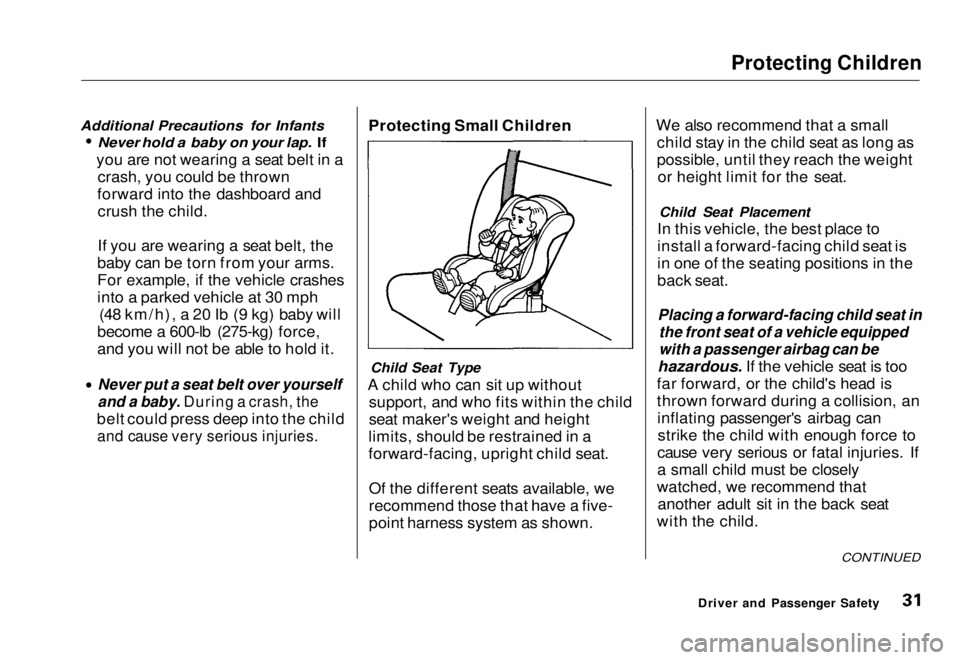
Protecting Children
Additional Precautions for Infants
Never hold a baby on your lap. If
you are not wearing a seat belt in a crash, you could be thrown
forward into the dashboard and crush the child.
If you are wearing a seat belt, the
baby can be torn from your arms.
For example, if the vehicle crashes
into a parked vehicle at 30 mph (48 km/h), a 20 Ib (9 kg) baby will
become a 600-lb (275-kg) force,
and you will not be able to hold it.
Never put a seat belt over yourself
and a baby. During a crash, the
belt could press deep into the child
and cause very serious injuries.
Protecting Small Children
Child Seat Type
A child who can sit up without support, and who fits within the child
seat maker's weight and height
limits, should be restrained in a
forward-facing, upright child seat.
Of the different seats available, we
recommend those that have a five-
point harness system as shown. We also recommend that a small
child stay in the child seat as long as
possible, until they reach the weightor height limit for the seat.
Child Seat Placement
In this vehicle, the best place to
install a forward-facing child seat is
in one of the seating positions in the
back seat.
Placing a forward-facing child seat in the front seat of a vehicle equipped
with a passenger airbag can be
hazardous. If the vehicle seat is too
far forward, or the child's head is
thrown forward during a collision, an inflating passenger's airbag canstrike the child with enough force to
cause very serious or fatal injuries. If
a small child must be closely
watched, we recommend that another adult sit in the back seat
with the child.
Driver and Passenger Safety
CONTINUEDMain Menu Table of Contents s t
Page 34 of 251
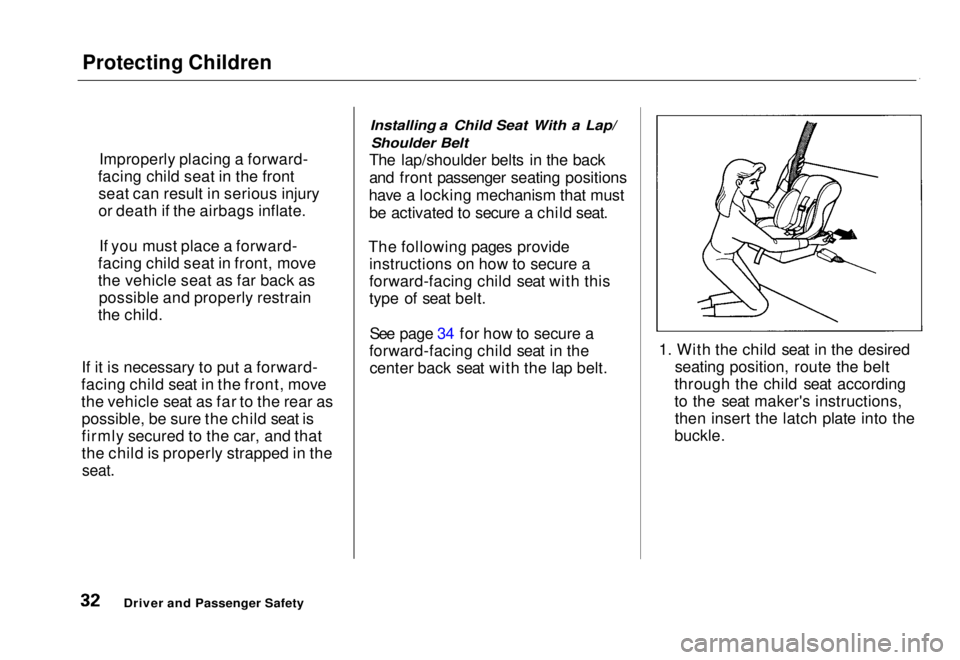
Protecting Children
If it is necessary to put a forward-
facing child seat in the front, move
the vehicle seat as far to the rear as possible, be sure the child seat is
firmly secured to the car, and that
the child is properly strapped in the
seat.
Installing a Child Seat With a Lap/
Shoulder Belt
The lap/shoulder belts in the back
and front passenger seating positions
have a locking mechanism that must be activated to secure a child seat.
The following pages provide instructions on how to secure a
forward-facing child seat with this
type of seat belt.
See page 34 for how to secure a
forward-facing child seat in the center back seat with the lap belt. 1. With the child seat in the desired
seating position, route the belt
through the child seat according
to the seat maker's instructions, then insert the latch plate into the
buckle.
Driver and Passenger Safety
Improperly placing a forward-
facing child seat in the front seat can result in serious injury
or death if the airbags inflate.
If you must place a forward-
facing child seat in front, move
the vehicle seat as far back as possible and properly restrain
the child.Main Menu Table of Contents s t
Page 37 of 251
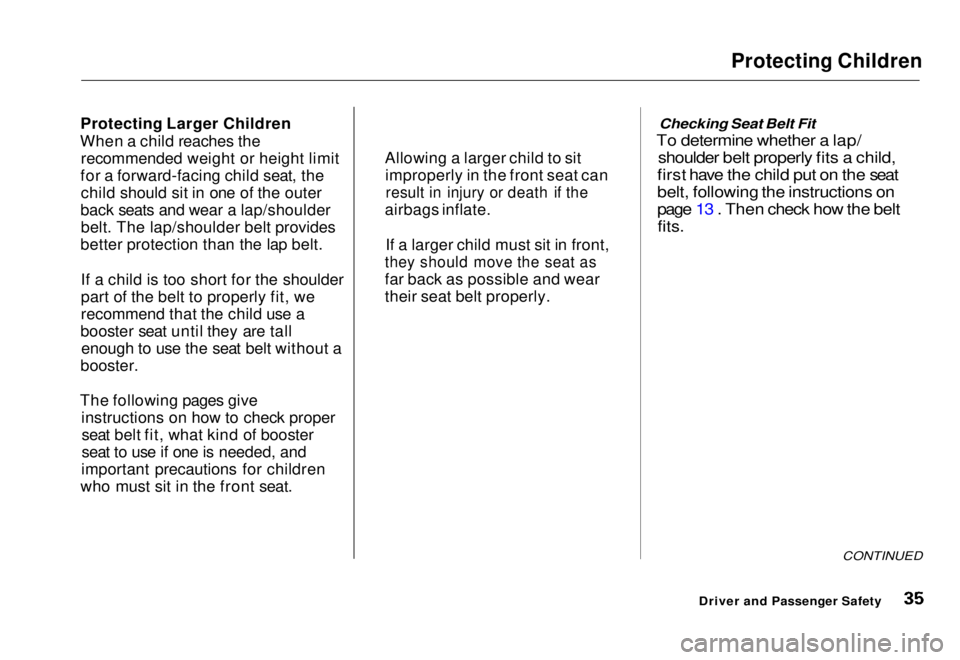
Protecting Children
Protecting Larger Children
When a child reaches the recommended weight or height limit
for a forward-facing child seat, the child should sit in one of the outer
back seats and wear a lap/shoulder belt. The lap/shoulder belt provides
better protection than the lap belt.
If a child is too short for the shoulder
part of the belt to properly fit, we
recommend that the child use a
booster seat until they are tall enough to use the seat belt without a
booster.
The following pages give instructions on how to check properseat belt fit, what kind of booster
seat to use if one is needed, and
important precautions for children
who must sit in the front seat.
Checking Seat Belt Fit
To determine whether a lap/ shoulder belt properly fits a child,
first have the child put on the seat
belt, following the instructions on
page 13 . Then check how the belt
fits.
CONTINUED
Driver and Passenger Safety
Allowing a larger child to sit
improperly in the front seat can
result in injury or death if the
airbags inflate.
If a larger child must sit in front,
they should move the seat as
far back as possible and wear
their seat belt properly.Main Menu Table of Contents s t
Page 39 of 251
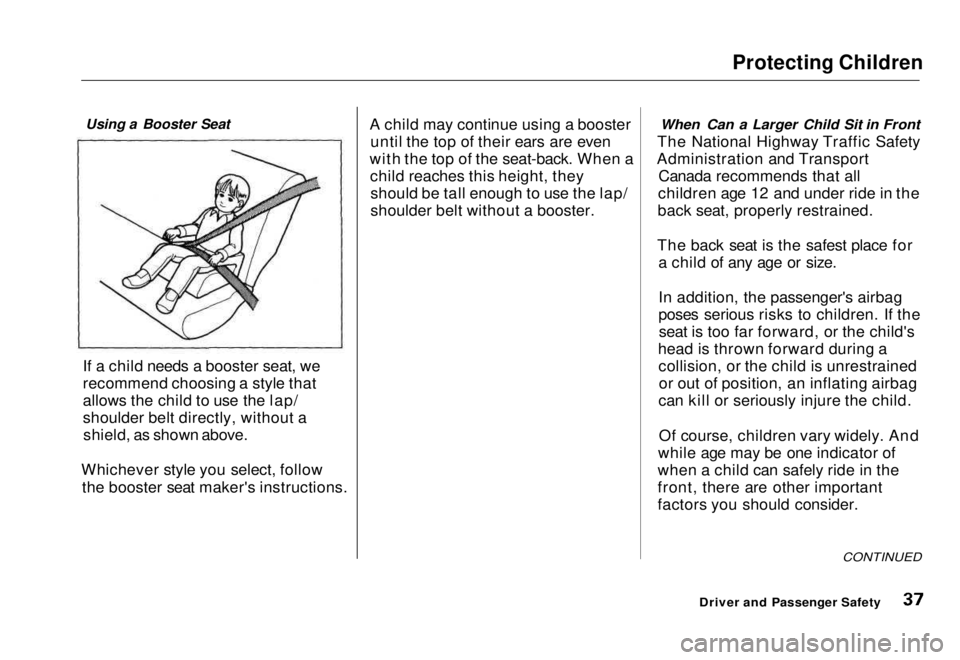
Protecting Children
Using a Booster Seat
If a child needs a booster seat, we
recommend choosing a style that
allows the child to use the lap/
shoulder belt directly, without a shield, as shown above.
Whichever style you select, follow the booster seat maker's instructions. A child may continue using a booster
until the top of their ears are even
with the top of the seat-back. When a child reaches this height, theyshould be tall enough to use the lap/
shoulder belt without a booster.
When Can a Larger Child Sit in Front
The National Highway Traffic Safety
Administration and Transport Canada recommends that all
children age 12 and under ride in the
back seat, properly restrained.
The back seat is the safest place for a child of any age or size.
In addition, the passenger's airbag
poses serious risks to children. If theseat is too far forward, or the child's
head is thrown forward during a collision, or the child is unrestrainedor out of position, an inflating airbag
can kill or seriously injure the child.
Of course, children vary widely. And
while age may be one indicator of
when a child can safely ride in the
front, there are other important
factors you should consider.
CONTINUED
Driver and Passenger SafetyMain Menu Table of Contents s t
Page 45 of 251
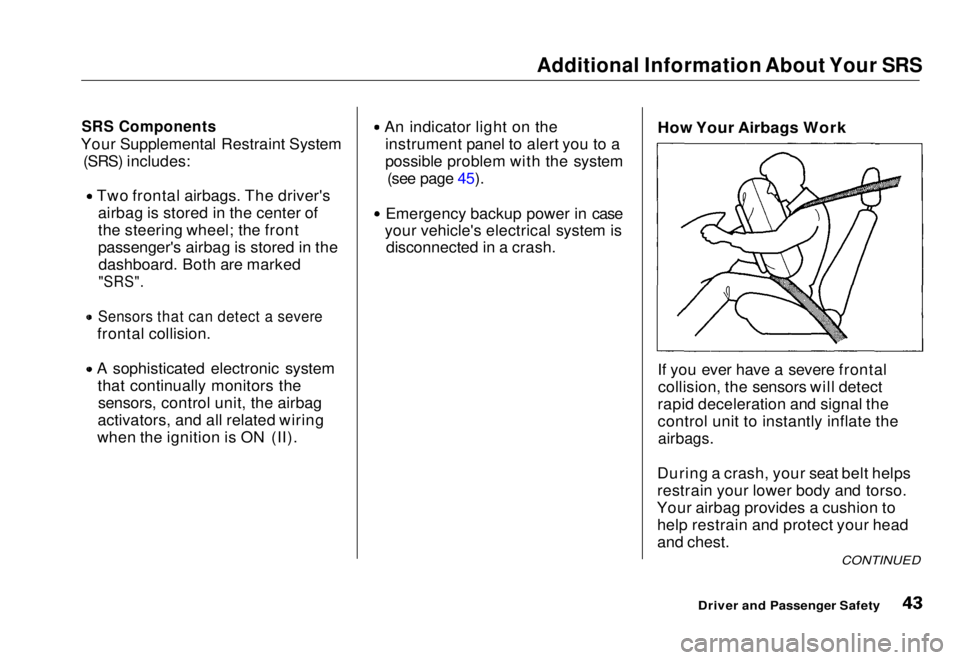
Additional Information About Your SRS
SRS Components
Your Supplemental Restraint System (SRS) includes:
Two frontal airbags. The driver'sairbag is stored in the center of
the steering wheel; the front
passenger's airbag is stored in thedashboard. Both are marked
"SRS".
Sensors that can detect a severe
frontal collision. A sophisticated electronic system
that continually monitors thesensors, control unit, the airbag
activators, and all related wiring
when the ignition is ON (II). An indicator light on the
instrument panel to alert you to a
possible problem with the system (see page 45). Emergency backup power in case
your vehicle's electrical system is disconnected in a crash.
How Your Airbags Work
If you ever have a severe frontal
collision, the sensors will detect
rapid deceleration and signal the
control unit to instantly inflate the
airbags.
During a crash, your seat belt helps
restrain your lower body and torso.
Your airbag provides a cushion to help restrain and protect your head
and chest.
CONTINUED
Driver and Passenger SafetyMain Menu Table of Contents s t
Page 46 of 251
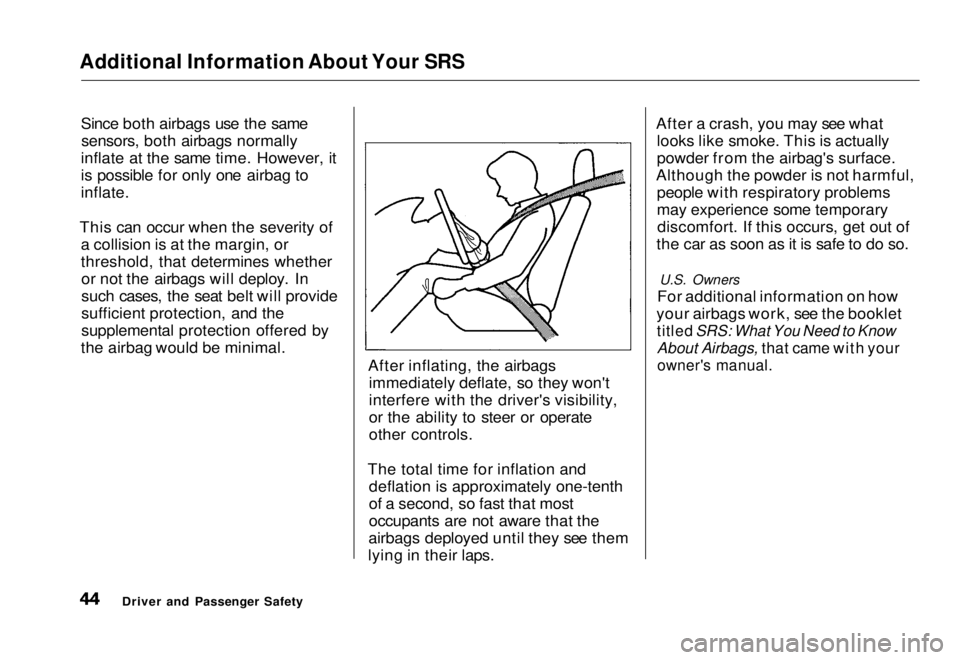
Additional Information About Your SRS
Since both airbags use the samesensors, both airbags normally
inflate at the same time. However, it
is possible for only one airbag to
inflate.
This can occur when the severity of a collision is at the margin, or
threshold, that determines whetheror not the airbags will deploy. In
such cases, the seat belt will provide
sufficient protection, and the
supplemental protection offered by
the airbag would be minimal.
After inflating, the airbagsimmediately deflate, so they won't
interfere with the driver's visibility,
or the ability to steer or operate
other controls.
The total time for inflation and deflation is approximately one-tenth
of a second, so fast that most
occupants are not aware that the
airbags deployed until they see them
lying in their laps. After a crash, you may see what
looks like smoke. This is actually
powder from the airbag's surface.
Although the powder is not harmful, people with respiratory problems
may experience some temporarydiscomfort. If this occurs, get out of
the car as soon as it is safe to do so.
U.S. Owners
For additional information on how
your airbags work, see the booklet
titled SRS: What You Need to Know
About Airbags, that came with your
owner's manual.
Driver and Passenger SafetyMain Menu Table of Contents s t
Page 47 of 251
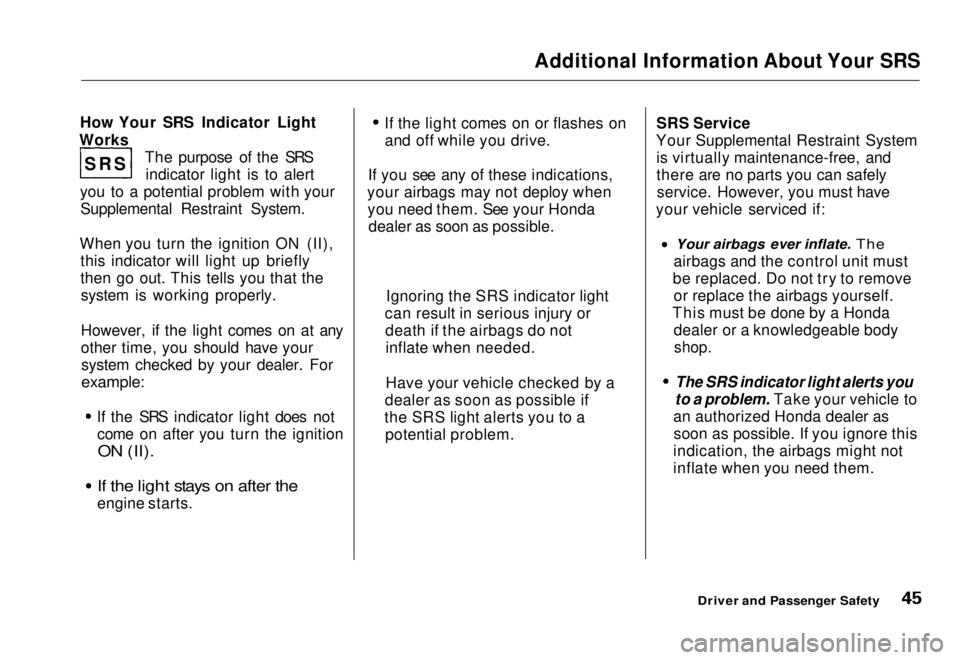
Additional Information About Your SRS
How Your SRS Indicator Light
Works The purpose of the SRSindicator light is to alert
you to a potential problem with your Supplemental Restraint System.
When you turn the ignition ON (II), this indicator will light up briefly
then go out. This tells you that thesystem is working properly.
However, if the light comes on at any
other time, you should have yoursystem checked by your dealer. For
example:
If the SRS indicator light does not
come on after you turn the ignition
ON (II). If the light stays on after the
engine starts. If the light comes on or flashes on
and off while you drive.
If you see any of these indications,
your airbags may not deploy when you need them. See your Honda dealer as soon as possible. SRS Service
Your Supplemental Restraint System is virtually maintenance-free, and
there are no parts you can safelyservice. However, you must have
your vehicle serviced if:
Your airbags ever inflate. The
airbags and
the control unit must
be replaced. Do not try to remove or replace the airbags yourself.
This must be done by a Honda dealer or a knowledgeable body
shop.
The SRS indicator light alerts you
to a problem. Take your vehicle to
an authorized Honda dealer as soon as possible. If you ignore this
indication, the airbags might not
inflate when you need them.
Driver and Passenger Safety
SRS
Ignoring the SRS indicator light
can result in serious injury or death if the airbags do notinflate when needed.
Have your vehicle checked by a
dealer as soon as possible if
the SRS light alerts you to a potential problem.Main Menu Table of Contents s t